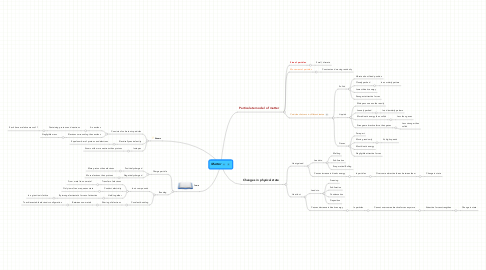
1. Atoms
1.1. Consists of sub-atomic particles
1.1.1. A neucleus
1.1.1.1. Containing protons and neutrons
1.1.1.1.1. Each have a relative mass of 1
1.1.2. Electrons surrounding the neucleus
1.1.2.1. Negligible mass
1.2. Electrically neutral entity
1.2.1. Equal number of protons and electrons
1.3. Isotopes
1.3.1. Atoms with more neutrons than protons
2. Ions
2.1. Charge particle
2.1.1. Positively charged
2.1.1.1. More protons than electrons
2.1.2. Negatively charged
2.1.2.1. More electrons than protons
2.2. Bonding
2.2.1. Ionic compounds
2.2.1.1. Transfer of electrons
2.2.1.1.1. From metal to non-metal
2.2.1.2. Conduct electricity
2.2.1.2.1. Only in molten or aqueous state
2.2.1.3. Held together
2.2.1.3.1. By strong electrostatic forces of attraction
2.2.2. Covalent bonding
2.2.2.1. Sharing of electrons
2.2.2.1.1. Between non-metals
3. Particulate model of matter
3.1. Size of particles
3.1.1. Small, discrete
3.2. Movement of particles
3.2.1. Constant and moving randomly
3.3. Particles of atoms in different states
3.3.1. Solids
3.3.1.1. Vibrate about fixed position
3.3.1.2. Closely packed
3.3.1.2.1. In an orderly pattern
3.3.1.3. Lowest kinetic energy
3.3.1.4. Strongest attractive forces
3.3.2. Liquids
3.3.2.1. Slide pass one another easily
3.3.2.2. Loosely packed
3.3.2.2.1. In a disorderly pattern
3.3.2.3. More kinetic energy than solids
3.3.2.3.1. Less than gases
3.3.2.4. Strongeer attractive force than gases
3.3.2.4.1. Less stronger than solids
3.3.3. Gases
3.3.3.1. Far apart
3.3.3.2. Moving randomly
3.3.3.2.1. At high speeds
3.3.3.3. Most kinetic energy
3.3.3.4. Negligible attractive forces
4. Changes in physical state
4.1. Heat gained
4.1.1. Leads to
4.1.1.1. Melting
4.1.1.2. Sublimation
4.1.1.3. Evaporation/Boiling
4.1.2. Causes increase in kinetic energy
4.1.2.1. In particles
4.1.2.1.1. Overcome attractive forces between them
4.2. Heat lost
4.2.1. Leads to
4.2.1.1. Freezing
4.2.1.2. Sublimation
4.2.1.3. Condensation
4.2.1.4. Deposition
4.2.2. Causes decrease in kinetic energy
4.2.2.1. In particles
4.2.2.1.1. Cannot overcome attractive forces anymore
